Memory Beta, non-canon Star Trek Wiki
A friendly reminder regarding spoilers ! At present the expanded Trek universe is in a period of major upheaval with the finale of Picard and the continuations of Discovery , Lower Decks , Prodigy and Strange New Worlds , the advent of new eras in Star Trek Online gaming , as well as other post-56th Anniversary publications such as the new ongoing IDW comic . Therefore, please be courteous to other users who may not be aware of current developments by using the {{ spoiler }}, {{ spoilers }} or {{ majorspoiler }} tags when adding new information from sources less than six months old . Also, please do not include details in the summary bar when editing pages and do not anticipate making additions relating to sources not yet in release. ' Thank You
- Memory Beta articles sourced from short stories
- Memory Beta articles sourced from novelizations
- Memory Beta articles sourced from eBooks
- Genetically engineered races and cultures
- View history
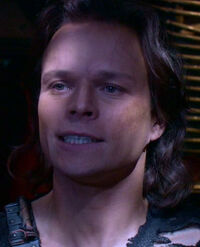
Malik, an Augment
Augment , in the general sense, is the designation given to a person or group that has been biologically altered to be physically and/or mentally superior to their base species. In more specific usage, the term "Augments" is applied to the genetically-enhanced "supermen" of Earth 's Eugenics Wars , and to similarly-altered humans in the centuries after.
- 1.1 The Eugenics Wars
- 1.2 The Neyel
- 1.3 The Augment Crisis
- 1.4.1 The Second Attempt
- 1.4.2 Romulans
- 1.5 Kelvin timeline
- 1.6 24th century augmentation
- 2.1 Aegis agents
- 2.2 Early Chrysalis Project
- 2.3.1 Chen Tiejun followers
- 2.3.2.1 Ceti Alpha V children
- 2.5 Changed
- 2.6 Arik Soong children
- 2.7 Paragon Colony
- 2.8 Empyreans
- 2.10 24th century
- 2.11 Children of Khan
- 3 List of known genetically engineered Romulans
- 4 Connections

History [ ]
The eugenics wars [ ].
The origins of the Augments were said to had been traced to a group of international scientists, such as Dr. Heisen , who worked during the 1960s - 1970s who had laboratories in Haiti and Pakistan as well as Chad along with their headquarters in North Yemen. These progenitors of a super race worked in the poorest countries on Earth as it was easy to bribe the officials into silence, take and hire human guinea pigs for their work. Unknown to him at the time, but Ralph Offenhouse supplied this cabal with equipment from electron microscopes to computers, drugs and even chemicals which broke export regulations and smuggling laws. ( TNG novel : Debtors' Planet , TOS - Khan comic : " Issue 1 ")
This led to the culmination of augmentation amongst the Human race through the production of the Chrysalis Project in the 20th century on the planet Earth . The goal was the creation of a race of superhuman beings, and the program was based on the previous work accomplished by the Nazis with the Lebensborn project. ( TOS novel : Star Trek: The Eugenics Wars , TOS novel : Unspoken Truth )
However, the projects goal whilst successful in breeding a superrace, they led to the creation of genetically engineered madmen that sought to dominate their non modified brethren. According to the journal of one of the scientists that were responsible for the creation of the Augments, "superior ability breeds superior ambition" . This log was written shortly before he was killed by his own creations. ( ENT episode : " The Augments ")
In 1993 , the Augments seized power within forty of the nations on the planet Earth which led to a conflict that was known as the Great Wars where they battled against normal Humans. The supermen were noted as being horrible despots that treated their unaltered human subjects as slaves and as a lower class. ( TOS episode : " Space Seed ")
Eventually, Khan Noonien Singh led a powerful group of fellow Augment warlords who formed the Great Khanate that sought to dominate their non-genetically engineered brethren. Forming the Augment Alliance , one of the chief leaders of this government was Stavos Keniclius who was second only to Khan himself. ( TOS - Strange New Worlds 9 short story : " The Rules of War ")
These augments were tyrants that devastated the world and united it against them in a conflict that would be known as the Eugenics Wars . ( TOS episode : " Space Seed ")
Despite noted for their brutality on their unaltered kin, they were noted for observing the rules of war in certain occasions as noted in the case when Keniclius negotiated a ceasefire with Nathan Archer in order to allow a school full of children to be evacuated in North Africa before resuming hostilities. ( TOS - Strange New Worlds 9 short story : " The Rules of War ")
A key conflict during this war was the Battle of the Sea of Japan where the naval vessel USS Enterprise was destroyed but not before leading a crucial victory for the governments of the world. This led to the destruction of Khan Singhs military and after the battle, the members of the Great Khanate splintered into dozens of factions that fought one another. This allowed the nations of Earth to hunt down the Augment leaders one by one which brought about an end to their tyrannical reign. ( TNG novel : Debtors' Planet )
The reign of the Augments ultimately ended in the year 1996 when they were overthrown. The last of these warlords was Khan Noonien Singh who was deposed but instead of being killed or captured; he managed to flee with eighty of his comrades in a sublight transport for parts unknown. ( TOS movie & novelization : The Wrath of Khan )
It was known that many of the 'Khans' took normal humans as spouses who in turn had children that were half augment and half human. These spouses and children would be preyed upon by society who would execute them for the crimes committed by the various supermen. However, some managed to flee with their children and went into hiding in locations such as the Sahara Reclamation Zone and Alaska. ( TNG novel : Infiltrator )
Some people and/or Augments did indeed escape Earth during and after the Wars, often ending up supporting Eugenics anyway. ( TOS comic : " Sceptre of the Sun ")
The Earth authorities were later responsible for confiscating the remaining Augment embryos and placed them into storage. By the 2130s , they were stored in an Earth Starfleet facility known as Cold Station 12 . ( ENT episode : " Cold Station 12 ")
The after effect of the Eugenics Wars led to genetic engineering being banned on the planet Earth which was one of the reasons why the first Human clone, Stavos Keniclius, was exiled from his homeworld. ( TAS episode : " The Infinite Vulcan ")
The Neyel [ ]
When the humans of the O'Neil asteroid colony were stranded far from Earth, they decided to defy Earth laws on genetic modification and began to augment themselves. This eventually led to altering themselves into a vastly different species who called themselves the Neyel . ( TLE novel : The Sundered )
The Augment Crisis [ ]
In the 22nd century a scientist, Dr Arik Soong , working at Cold Station 12 , where the 20th century augment embryos were stored, saw potential in augmentation and decided to continue the development of the program and managed to escape with several of the embryos. He raised them as his children until he was captured by United Earth Starfleet . A decade later, these children sparked the Augment Crisis that nearly incited a full-scale war between the Klingon Empire and the relatively new interstellar power of United Earth . The Augments once again attempted to make a break for power and showed that they had no trouble with committing genocide on other worlds to achieve their goals. ( ENT episodes : " Borderland ", " Cold Station 12 ")
The group eventually turned on their "father," who was attempting to modify their genes to remove their aggressive characteristics. They and the remainder of the eighteen hundred 20th century embryos were killed when the United Earth Starfleet starship Enterprise destroyed their captured Bird-of-prey . ( ENT episode : " The Augments ")
Klingons [ ]
The Klingons were both impressed and fearful of the potential of the Human augments, and were the next to experiment with augmentation. Using gene therapy based on Augment DNA they obtained from the wreckage of the Bird-of-Prey the Human Augments had commandeered, they attempted to create their own augments. Their experiments were initially successful in increasing strength and intelligence, but did have two side effects: the Klingon cranial ridges dissolved, and eventually led to an agonizing death as the subject's neural pathways degraded. One of the test subjects had Levodian flu , and the virus combined with the Augment DNA to create an airborne plague that quickly spread throughout the empire, infecting billions of Klingons and causing them to lose their ridges.
All of the infected Klingons would have eventually died, but fortunately for them, a cure was developed by the Klingon Antaak and Dr Phlox of the Earth starship Enterprise . Whilst the cure prevented the deaths of many Klingons, it did leave them ridgeless, an effect which would be passed onto their children. ( ENT episodes : " Affliction ", " Divergence ")
These Klingons became known as QuchHa' . ( VAN novel : Summon the Thunder )
The Second Attempt [ ]
Dozens of years later, a Klingon scientist known as Qadar attempted to create "enhanced" Klingon warriors called M'tachtar , which he re-engineered (along with himself) into a force that would be used against the Federation . He was stopped and exiled along with his warriors by his Rustaai -cousin Emperor of the Klingon Empire Grannoch . They remained on an uninhabited planet until they managed to take over the USS Enterprise under the command of Captain James T. Kirk . Qadar and his followers attempted to return to Qo'noS and take command of the Empire, but were quickly defeated. They still returned to Qo'noS, but their is fate is unknown. Presumably, they were executed for their attempted coup against the ruler of the Klingon Empire. ( TOS - My Brother's Keeper novel : Enterprise )
Romulans [ ]
The Romulan Star Empire attempted their own eugenics program in the 2260s which resulted in the Hellguard colony. When this project was considered no longer valuable, the 'rejects' were left behind. The survivors of this abandonment were rescued by Spock in 2274 . ( TOS novels : The Pandora Principle , Unspoken Truth )
Kelvin timeline [ ]
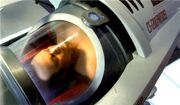
A cryotube with an augment inside
Following the Destruction of Vulcan in 2258 of the Kelvin timeline , Section 31 then started to look for ways to militarize Starfleet. One of their ships, the USS Vanguard discovered Khan and 72 of his fellow augments in cyrotubes aboard the SS Botany Bay . Khan was then surgically altered and recruited into Section 31 under alias "John Harrison". Section 31 then threatened to kill his crew if he did not cooperate with Section 31.( TOS - Khan comics : " Issue 1- ", " Issue 5 "; TOS movie & novelization : Into Darkness )
Khan then attempted to retrieve his crew, but Admiral Alexander Marcus discovered his plans. Khan then started his one-man war on the Federation in order to retrieve his crew. However, his attempt failed and he was placed back into the cryotube and sent to a asteroird facily.( TOS - Khan comics : " Issue 1- ", " Issue 5 "; TOS movie & novelization : Into Darkness ; TOS - Stranger Worlds comics : " Issues 1- ", " 6 ")
24th century augmentation [ ]
Earth's restrictions on genetic modification eventually spread to the Federation , however there were a few colonies that performed the necessary operations illegally. ( TNG episode : " Up the Long Ladder ")
This included operations that did not bestow the full "gifts" of augmentation, but rather specific aspects such as increased intelligence or improved motor skills. ( TNG episode : " The Masterpiece Society ")
Ethan Locken and Dr. Julian Bashir were two such augments. ( DS9 episode : " Doctor Bashir, I Presume "; DS9 novel : Abyss )
There was also a group of humans on the planet Hera who ignored the Federation law and routinely practiced genetic modification to a similar degree of the augmentation in the Eugenics Wars. This group called themselves Herans and believed that they were superior to "Old Humans." They planned to use a genetically engineered virus that would have converted all newborn children into augments, however, they faced a Human renegade faction on their homeworld who resisted their attempts. ( TNG novel : Infiltrator )
In 2376 , Doctor Elizabeth Lense affected a widespread, but temporary, genetic augmentation of the population of Sherman's Planet in order to combat a pandemic disease dubbed " Sherman's Plague ". This action was justified by arguing, because the population could not survive in the environment they were born into, this constituted a birth defect which could legally be treated. Though Lense herself had been suspected of being augmented years earlier, she believed the Federation's laws on genetic modification deserved review. ( SCE eBook : Oaths )
List of known genetically engineered Humans [ ]
Aegis agents [ ], early chrysalis project [ ], chrysalis project children [ ], chen tiejun followers [ ], khan noonien singh followers [ ], ceti alpha v children [ ], changed [ ], arik soong children [ ], paragon colony [ ], empyreans [ ], 24th century [ ], children of khan [ ], list of known genetically engineered romulans [ ], connections [ ].
- Augment article at Memory Alpha , the wiki for canon Star Trek .
- 1 Odyssey class
- 2 Ferengi Rules of Acquisition
- 3 USS Enterprise (NCC-1701-F)
Star Trek: Strange New Worlds: Augments, Illyrians and the Eugenics Wars
Why first officer Una Chin-Riley was on trial, and how it links all the way back to Khan Noonien Singh.

Warning: Spoilers ahead if you haven't watched "Star Trek: Strange New Worlds" season 2, episode 2, " Ad Astra per Aspera ".
From original series two-parter "The Menagerie" to "The Next Generation" classic "The Measure of a Man", "Star Trek" has always loved a courtroom drama. "Ad Astra per Aspera" continues the tradition, as USS Enterprise first officer Una Chin-Riley (aka Number One) goes on trial.
Her crime? Nothing more than being an Illyrian, a species whose penchant for genetic modification puts them at odds with Federation laws preventing anyone from tinkering around with their DNA.
Una's predicament has its roots in the story of the infamously wrathful Khan Noonien Singh, and also ties into plotlines explored in "Deep Space Nine", "Enterprise" and "Picard". It's also certain to have further implications for "Strange New Worlds," so here's everything you need to know about Augments, Illyrians and the Eugenics Wars.
Why is Una on trial in "Strange New Worlds" season 2?
Simply because of who she is and where she comes from.
In season 1 episode "Ghosts of Illyria " confirmed that the USS Enterprise's highly respected first officer is an Illyrian, a species whose use of genetic modifications contravenes long-standing Federation laws. These rules would have prevented her from serving in Starfleet, so she's kept her heritage hidden throughout her career.
Although Captain Pike opted to keep Number One's secret when he learned the truth about her origins origins, someone else spilled the beans, leading to Una's arrest in season 1 finale 'A Quality of Mercy '.
During the trial, it was revealed that it was actually Una who'd reported herself to the authorities in the hope that her case might help the blinkered Starfleet authorities understand Illyrians a better. She also wanted her crew to know her for who she really was, and to finally feel safe. Her counsel, Neera Ketoul (a fellow Illyrian), successfully argued that Pike was effectively granting Una asylum from persecution by allowing her to remain on the Enterprise, and the charges against her were dropped.

Watch Star Trek: Strange New Worlds on Paramount+:
<a href="https://paramountplus.qflm.net/c/221109/175360/3065?subId1=hawk-custom-tracking&sharedId=hawk&u=https%3A%2F%2Fwww.paramountplus.com%2Faccount%2Fsignup%2Fpickplan" data-link-merchant="paramountplus.com"" target="_blank" rel="nofollow"> Essential (ads) - $4.99/mo or $49.99/yr
<a href="https://paramountplus.qflm.net/c/221109/175360/3065?subId1=hawk-custom-tracking&sharedId=hawk&u=https%3A%2F%2Fwww.paramountplus.com%2Faccount%2Fsignup%2Fpickplan" data-link-merchant="paramountplus.com"" data-link-merchant="paramountplus.com"" target="_blank" rel="nofollow"> Premium (no ads) - $9.99/mo or $99.99/yr
What is an Illyrian?
Although Una looks human, Illyrians are a different species entirely, hailing from the Delphic Expanse that was also home to "Star Trek: Enterprise" antagonists the Xindi.
Rather than trying to adapt new worlds to suit their needs, the Illyrians use genetic modification techniques to adapt their bodies to new, often hostile environments – Una's augmentations give her superhuman healing abilities, as well as the ability to literally light up a room.
This penchant for fiddling around with DNA means that their appearance can vary greatly, ranging from the human-like Una, to subtly webbed hands and feet, and the sort of lumpy-foreheaded alien look that's a mainstay of the franchise.
Have we always known that Una is an Illyrian?
Number One’s first appearance in original "Star Trek" pilot "The Cage" (made in 1965) didn't tell us much (if anything) about her backstory, and there was little to make us suspect she was an alien – indeed, back then the ship's extra-terrestrial quotient effectively consisted of Mr Spock.
However, legendary "Trek" writer DC Fontana did allude to Number One's origins in non-canonical 1989 novel "Vulcan's Glory", where Pike explained that, "Some officers have a difficult time dealing with the fact that she is a genetically perfect being. On her planet, Illyria, excellence is the only criterion that is accepted."
This relatively obscure piece of "Trek" lore has subsequently been reinvented and retconned into official canon.
Why does Starfleet have an issue with Illyrians?
It's not so much the Illyrian people as their penchant for genetic modification, a practice that was made illegal in the wake of the Eugenics Wars that ravaged Earth in the late 20th century and early 21st century.
What were the Eugenics Wars?
When a group of 20th century scientists successfully engineered a group of men and women who were stronger, faster and more intelligent than your average human, they didn't account for one important detail – these so-called Augments had a massive superiority complex that resulted in an unstoppable desire to conquer and subjugate ordinary homo sapiens. The most famous/infamous of these superhumans, a certain Khan Noonien Singh, came to rule a quarter of the Earth, across Asia and the Middle East.
"Trek" history is a little fuzzy on the subject of whether the subsequent Eugenics Wars were fought between the Augments themselves, or by ordinary humans looking to overthrow their GM overlords. Either way, we do know that millions of people died, and that much of the planet was laid to waste in a conflict that subsequently escalated into a fully blown World War III.
With Augments blamed and ostracized for the near-destruction of Earth, the authorities moved to ban all genetic engineering on humans – a resolution that remained in place for centuries.
When exactly did the Eugenics Wars take place?
That's a good question. While various "Star Trek" movies and TV shows have alluded to the 21st century being a post-apocalyptic wasteland – and Khan's first appearance in original series episode "Space Seed" dated the Eugenics Wars between 1992-96 – this doesn't tally with "Star Trek: Picard" season 2's extended stay in a very normal 2024 or, indeed, the real world.
But we wonder if the "Trek" chronology might be going through a bit of subtle retconning to make the timeline a little more plausible. Data's "ancestor" Adam Soong pulling out a file labelled "Project Khan" (dated 1996) in the "Picard" season 2 finale certainly suggests Khan could have been born later than we originally thought – unless, of course, the file refers to a plan to replicate a whole new generation of superbeings from Khan's "superior" DNA.
And tweaks like this seem entirely justified as the franchise evolves – as regular ’90s scripter Ronald D Moore put it to Cinefantastique, "What looked like the distant future in 1967 [when 'Space Seed' was broadcast'] is not so distant any more. I don't blame them for not having the foresight to see that in 30 years this would be important in the series."
Are there any other Augments in "Star Trek" lore?
"Trek" has explored the implications of genetic manipulation on several occasions. The most famous example was arguably "Deep Space Nine" medic Dr Julian Bashir, who was shocked to learn that his father had played around with his DNA when he was a kid, with the aim of making him less of a disappointment. While Bashir Sr was never going to win dad of the year, the augmentations to his boy resulted in enhanced mental agility, super-fast reflexes and improved hearing. Despite the Federation's ban on such modifications, Bashir was allowed to remain in Starfleet when his dad agreed to go to prison for his crimes.
Related: Best Star Trek Deep Space Nine Episodes
"Enterprise" also ventured into GM territory, with a plot line about another of Data's ancestors, Arik Soong, set out to prove that Augments wouldn't automatically grow up to be bad 'uns like Khan.
Soong's work was later adapted by Klingons looking to make Augments of their own. Their plan backfired, however, proving lethal until Dr. Phlox engineered a cure that – conveniently for overall continuity – gave a group of Klingons the smooth-foreheaded appearance they had in the era of the original series. When Worf told his confused DS9 crewmates "We do not discuss it with outsiders" in classic flashback episode "Trials and Tribble-ations", this anomaly was what he was talking about.
And Una's shipmate, La'an Noonien Singh, is a descendant of Khan. She lives in fear that genetic modifications may suddenly manifest themselves, making her a danger to the Enterprise crew.
Join our Space Forums to keep talking space on the latest missions, night sky and more! And if you have a news tip, correction or comment, let us know at: [email protected].
Get the Space.com Newsletter
Breaking space news, the latest updates on rocket launches, skywatching events and more!
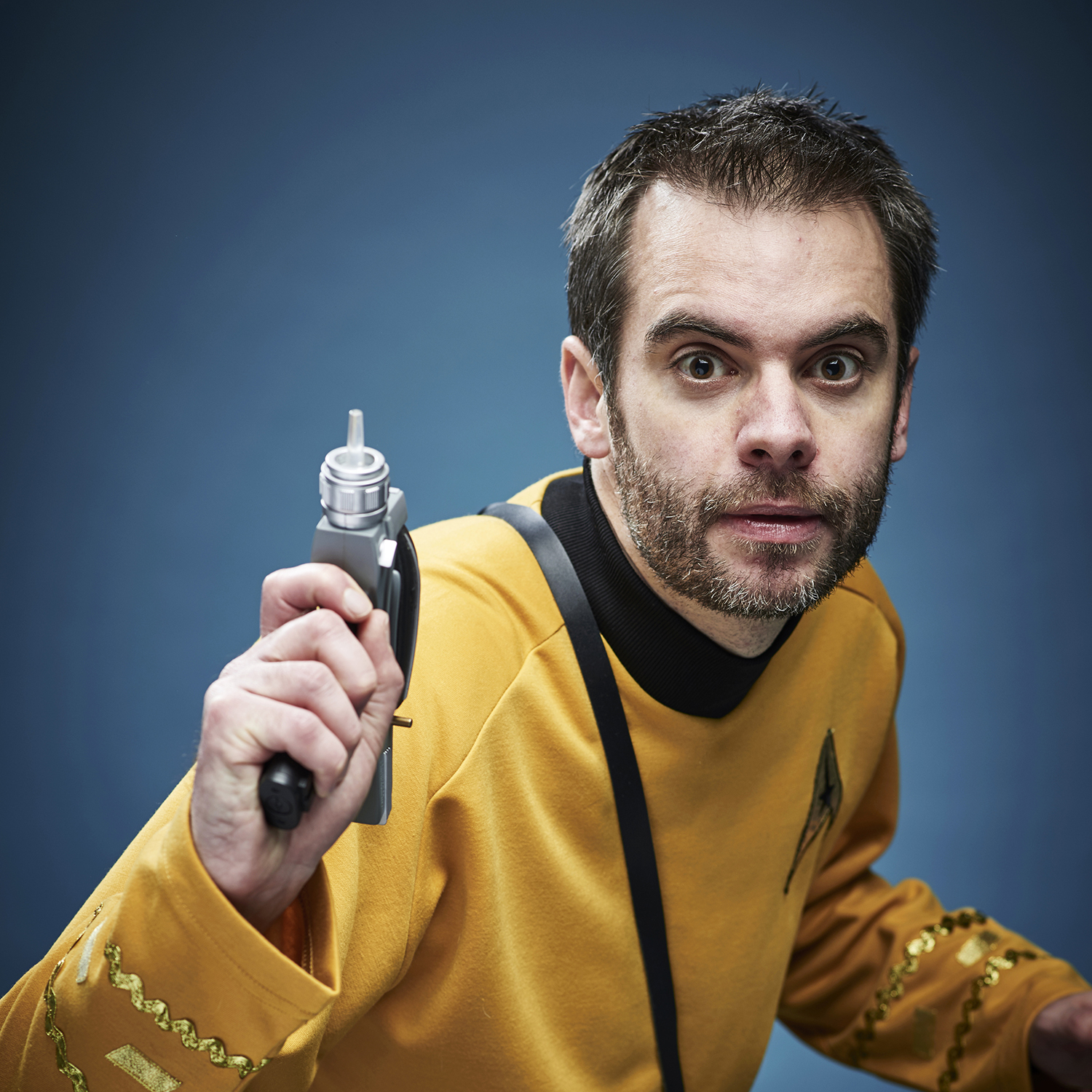
Richard's love affair with outer space started when he saw the original "Star Wars" on TV aged four, and he spent much of the ’90s watching "Star Trek”, "Babylon 5” and “The X-Files" with his mum. After studying physics at university, he became a journalist, swapped science fact for science fiction, and hit the jackpot when he joined the team at SFX, the UK's biggest sci-fi and fantasy magazine. He liked it so much he stayed there for 12 years, four of them as editor.
He's since gone freelance and passes his time writing about "Star Wars", "Star Trek" and superheroes for the likes of SFX, Total Film, TechRadar and GamesRadar+. He has met five Doctors, two Starfleet captains and one Luke Skywalker, and once sat in the cockpit of "Red Dwarf"'s Starbug.
'Constellation' season 1 episode 7 review: Fumbling around in the dark
Watch rockin' new trailer for Zack Snyder's 'Rebel Moon Part Two: The Scargiver' (video)
Watch SpaceX launch its 30th Dragon cargo mission to the ISS today
- Atlan0001 Star trek's 'Augmentee' territory = Star Wars' 'Jedi / Sith' territory. Reply
- View All 1 Comment
Most Popular
By Fran Ruiz January 26, 2024
By Conor Feehly January 05, 2024
By Keith Cooper December 22, 2023
By Fran Ruiz December 20, 2023
By Fran Ruiz December 19, 2023
By Fran Ruiz December 18, 2023
By Tantse Walter December 18, 2023
By Robert Lea December 05, 2023
By Robert Lea December 04, 2023
By Robert Lea December 01, 2023
By Rebecca Sohn November 27, 2023
- 2 What is the most distant thing we can see?
- 3 SpaceX's Starship could fly again as soon as early May
- 4 China launches satellite to support future moon missions (video)
- 5 1 in 12 stars might have swallowed a planet
- More to Explore
- Series & Movies
Published Nov 16, 2023
Enterprise’s Ambitious Arcs
Revisit the birth of the Federation with these classic Star Trek: Enterprise storylines.
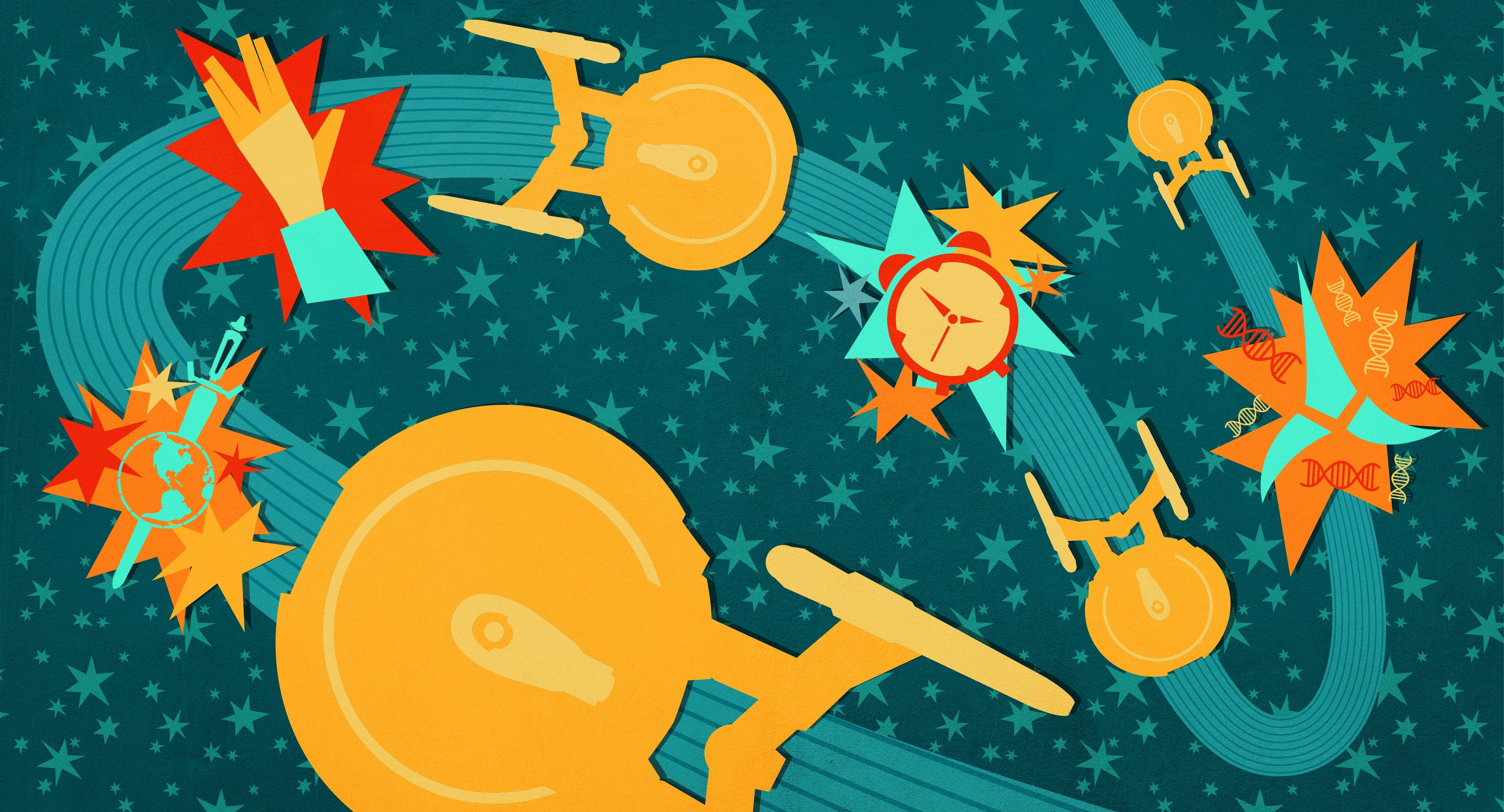
StarTrek.com
From The Original Series ' “ The Menagerie ” duology to the lengthy struggle against the Dominion as depicted in Deep Space Nine , the Star Trek franchise has never been a stranger to epic, multi-episode story arcs. Discovery and Picard have even been organized into season-long narratives, where each year’s adventures are dedicated to pursuing a specific plot.
However, no other Trek series has attempted what Enterprise accomplished in its popular fourth season — a year’s worth of episodes almost entirely divided into mini-arcs consisting of two- and three-part storylines. These installments served as exciting entries in the NX-01 Enterprise ’s journey while simultaneously connecting the show with other elements of Star Trek lore.
Let’s look back on the intriguing escapades chronicled in its final season.
1. The Temporal Cold War (" Storm Front " and " Storm Front, Part II ")
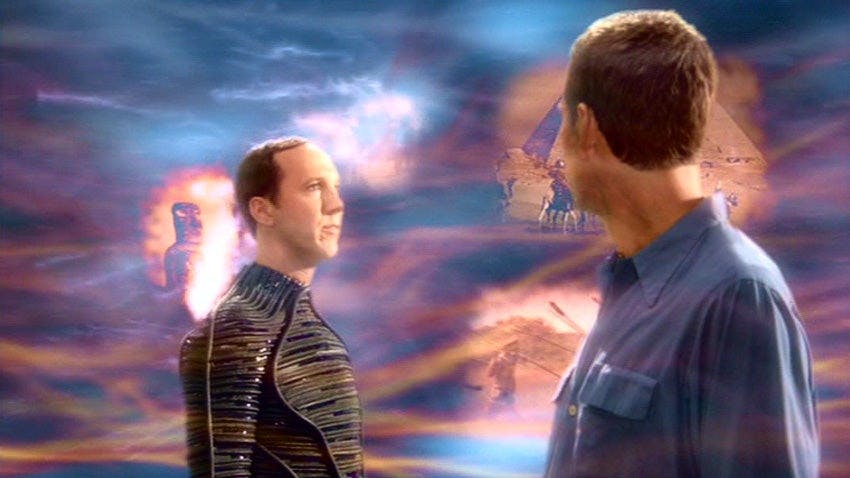
"Storm Front, Part II"
Fresh off of a yearlong search for the Xindi superweapon, Captain Archer and his crew found themselves transported back in time to a distorted version of Earth’s Second World War by the 31st Century temporal agent Daniels. Hoping to stop a cadre of 29th Century operatives from manipulating the timeline, Daniels once again enlisted Enterprise to intervene in the Temporal Cold War. Unbeknownst to anyone, the Suliban Silik stowed away on the mission and assisted Archer in foiling the plot spearheaded by an alien known as Vosk. The successful resolution prompted Daniels to send Enterprise to its proper time period.
This duology acted as the conclusion to Archer’s dealings with both temporal agents and the Suliban, two groups who the captain encountered on a fairly regular basis during the early phase of Enterprise ’s travels. According to Daniels, Vosk’s defeat helped bring about the end of the Temporal Cold War, a conflict that tied directly into Discovery ’s third season. Once Michael Burnham arrived in the 32nd Century, she learned that the war resulted in a ban on time travel. The disarray caused by the numerous temporal factions also distracted the Federation in the years leading up to The Burn.
2. The Augment Crisis (" Borderland ," "Cold Station 12," and "The Augments")
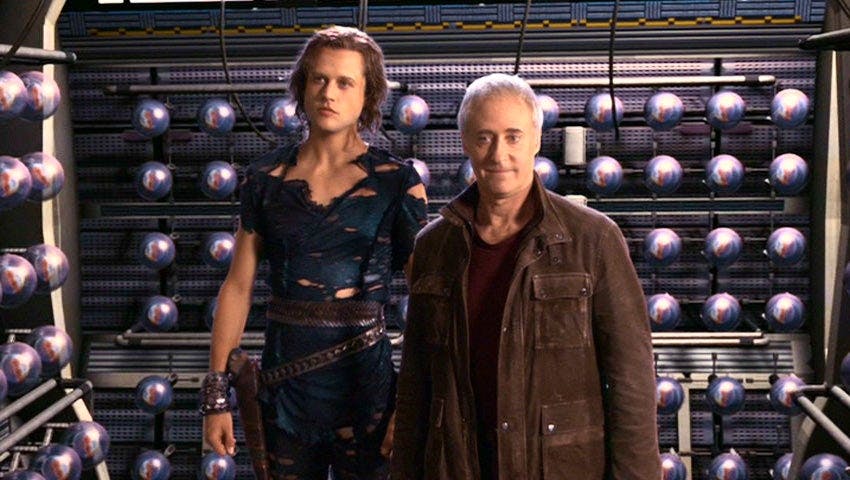
"Cold Station 12"
After genetically-enhanced humans attacked a Klingon Bird-of-Prey, Archer recruited their adoptive father, Arik Soong, to accompany Enterprise on an excursion to capture the Augments and prevent a war between the Federation and the Empire. Soong initially sympathized with his children, but his son Malik’s grandiose ambitions ultimately led the scientist to realize that the Augments were too dangerous to roam the galaxy. Enterprise narrowly managed to intervene before Malik released a biological weapon over a Klingon colony, and the remaining Augments were presumed to have perished along with their vessel.
This trilogy supplied a wealth of background information about the Augments and the Eugenics Wars, subjects that were initially touched upon as Kirk battled Khan Noonien Singh in The Original Series episode “ Space Seed ” and Star Trek II: The Wrath of Khan . Links to The Next Generation -era also abounded, as Arik Soong was an ancestor of Data’s creator Noonian Soong. Upon returning to prison at the end of the arc, Arik mentioned that he intended to shift his focus to cybernetics and artificial lifeforms. While Starfleet temporarily averted a war with the Klingons, a conflict between the two powers ensued a century later during Discovery ’s first season.
3. The Vulcan Reformation ("The Forge," "Awakening," and "Kir’Shara")
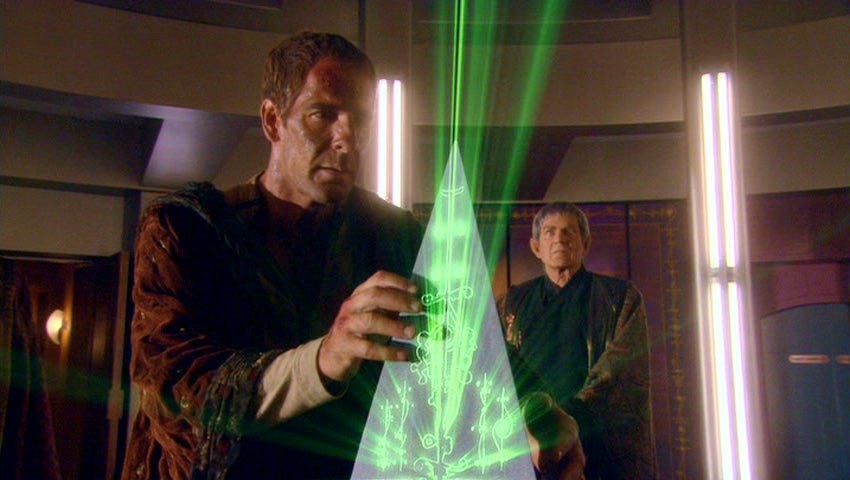
"Kir'Shara"
A faction known as the Syrannites received blame for a deadly bombing at Earth’s embassy on Vulcan, so Archer and T’Pol set out to locate a potential suspect named T’Pau. The two encountered Syrran himself, who transferred Surak’s katra to Archer on his deathbed. At the same time, Vulcan Administrator V’Las raised the stakes by firing on Enterprise and accusing the Andorians of planning an invasion. Archer halted the hostilities when he located the Kir’Shara, which stored Surak’s true teachings, and smuggled the artifact to the High Command. Soon afterward, V’Las held a secret meeting with a Romulan operative to discuss reunification.
First introduced in The Original Series episode “ Amok Time ,” T’Pau appeared as her younger self in this arc, while Syrran’s interrogation of Archer featured questions originally heard in Star Trek IV: The Voyage Home . The dissolution of the High Command and reformation of Vulcan society opened the door for improved Earth-Vulcan relations and paved the way for the Coalition of Planets. While V’Las’s discussion about reunification implied a Romulan takeover of Vulcan, the concept nevertheless suggested a connection to Ambassador Spock’s desire for a diplomatic reunion in The Next Generation two-parter “ Unification .” Discovery ’s “ Unification III ” established that Spock’s peaceful efforts prevailed centuries after his death.
4. The Federation's Preamble ("Babel One," "United," and "The Aenar")
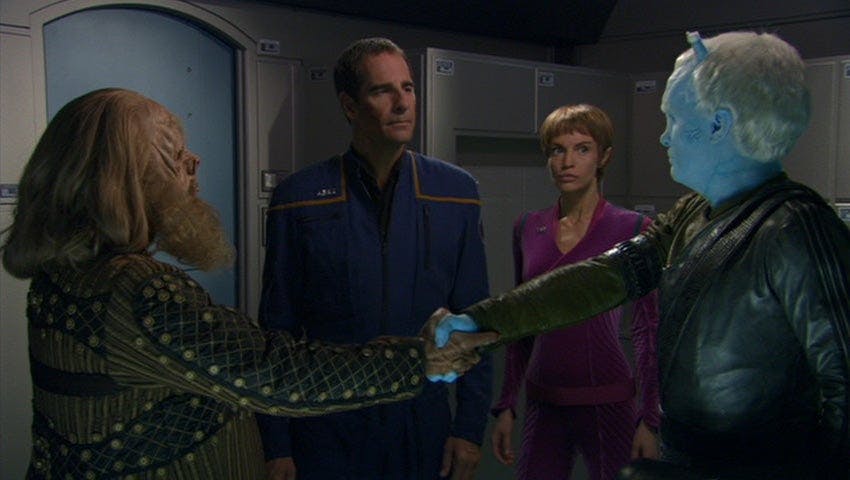
"United"
A starship of unknown origin utilized holographic technology to hide its true identity so that it could destabilize diplomatic relations between humans, Andorians, Tellarites, Vulcans, and Rigelians. Unbeknownst to those species, the craft was under the remote command of Romulan Admiral Valdore. With Archer’s leadership, the Andorians, Tellarites, and Vulcans joined Enterprise in a hunt for the elusive vessel. Having lifted the veil on the plot, Archer and Shran learned that a captured Aenar was controlling the vessel and worked alongside the pilot’s sister to convince him to destroy the experimental Romulan weapons.
As its title suggested, the first entry in this trilogy began with Enterprise transporting a Tellarite delegation to Babel, the same location that Captain Kirk escorted Federation dignitaries to in The Original Series episode “ Journey to Babel .”
Additionally, the cooperation Archer organized between the local species acted as another cornerstone for the Coalition that would be founded in the coming years, particularly in light of the alliance initiated by the Andorians and Tellarites. Although Archer and his associates never definitively proved the Romulans were behind the attacks, Romulus’ interest in interfering with Earth would later resurface during the war that Spock described in “ Balance of Terror .”
5. The Klingon Contagion (“ Affliction ” and “ Divergence ”)

"Divergence"
In order to halt a devastating virus ravaging the Empire, the Klingons abducted Doctor Phlox so that he could work to find a solution. Outraged when he learned the virus had been caused by Klingon experimentation with DNA harvested from Augment embryos, Phlox refused to partake in any efforts to create Klingon Augments. Luckily, Phlox’s Klingon counterpart Antaak devised a method of halting the virus without amplifying the subjects’ intelligence or strength, a process which was accelerated when Archer allowed Phlox to use him to produce antibodies at an expedited rate.
This two-parter is primarily remembered for illustrating why Klingons appeared without cranial ridges in The Original Series. Antaak mentioned a potential for reconstructive surgery, which would also explain why Kor, Kang, and Koloth appeared with intact ridges on Deep Space Nine . The episodes cleverly incorporated information from the Augment arc that occurred earlier in Enterprise ’s fourth season.
While not specifically named, Malcolm Reed contacted a former employer who was clearly an agent of Section 31, an organization that would be further explored in DS9 and Discovery .
6. The Mirror Universe (" In A Mirror, Darkly " and " In A Mirror, Darkly, Part II ")
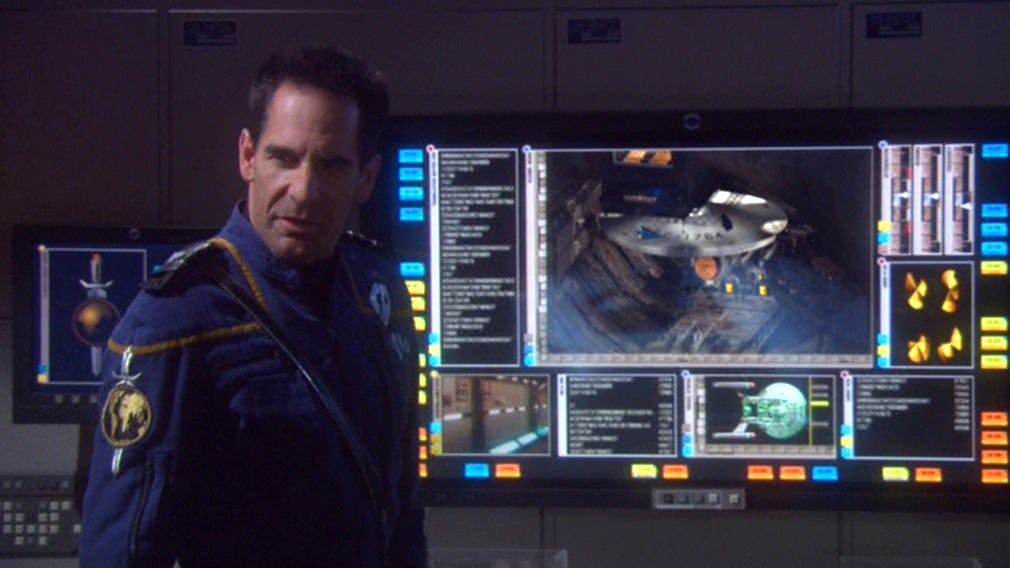
"In A Mirror, Darkly"
Set entirely in the Mirror Universe, this duology held the unique distinction of being a prequel to The Original Series episode “ Mirror, Mirror ” and a sequel to “ The Tholian Web .”
The two entries cataloged the Terran Empire’s fight against rebels a century before Kirk made his trip to this alternate dimension while also following up on the disappearance of the U.S.S. Defiant that took place in Tholian space. The alien uprisings foreshadowed the Terran Empire’s demise that was predicted by Mirror Spock and showcased in DS9’s own ventures into the Mirror Universe. These events also connected to Emperor Georgiou’s rule in Discovery , as rebels plagued the Empire in her era, as well.
7. The Coalition Confrontation (" Demons " and " Terra Prime ")
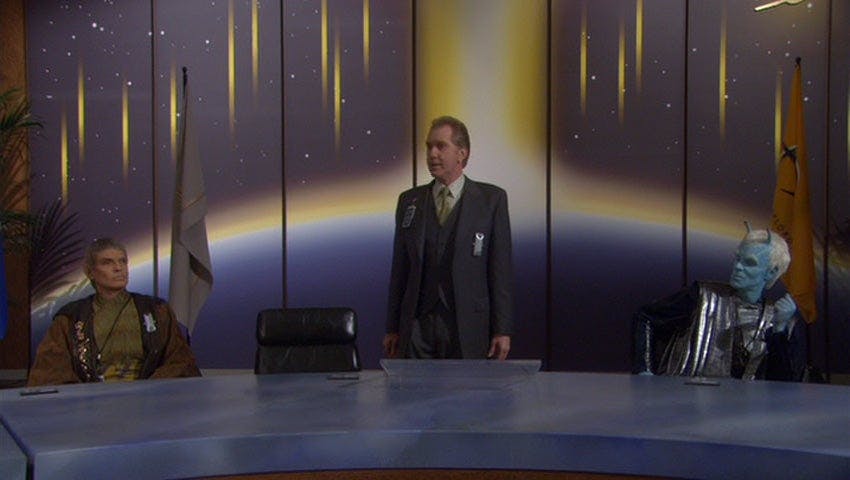
"Demons"
With a conference taking place to discuss the creation of a Coalition of Planets, John Frederick Paxton sought to foil the peaceful proceedings and spread the xenophobic message he shared with Colonel Green, a version of whom was initially seen in TOS’ “ The Savage Curtain .”
Paxton harvested Charles Tucker and T’Pol’s DNA to clone a Human-Vulcan child as a means to stir up anti-alien sentiments, but Archer and his crew defeated Paxton and succeeded in keeping the diplomatic meetings on track. The conference formed the seeds of a Coalition, which eventually gave birth to a Federation that endured into the 32nd Century. Although Tucker and T’Pol’s daughter perished, Phlox discovered that it was due to a cloning error rather than DNA incompatibility. This information explained the future presence of Human-Vulcan children, including our beloved Mister Spock.
Get Updates By Email
This article was originally published on April 17, 2021.
Jay Stobie (he/him) is a freelance writer, author, and consultant who has contributed articles to StarTrek.com, Star Trek Explorer, and Star Trek Magazine, as well as to Star Wars Insider and StarWars.com. Learn more about Jay by visiting JayStobie.com or finding him on Twitter, Instagram, and other social media platforms at @StobiesGalaxy.
Star Trek: Discovery Seasons 1 through 4 are currently streaming exclusively on Paramount+ in the U.S., the UK, Switzerland, South Korea, Latin America, Germany, France, Italy, Australia and Austria. Seasons 2 and 3 also are available on the Pluto TV “Star Trek” channel in Switzerland, Germany and Austria. In Canada, the series airs on Bell Media’s CTV Sci-Fi Channel. Seasons 1 to 4 of Star Trek: Discovery is also available to stream on SkyShowtime. Star Trek: Discovery is distributed by Paramount Global Content Distribution.
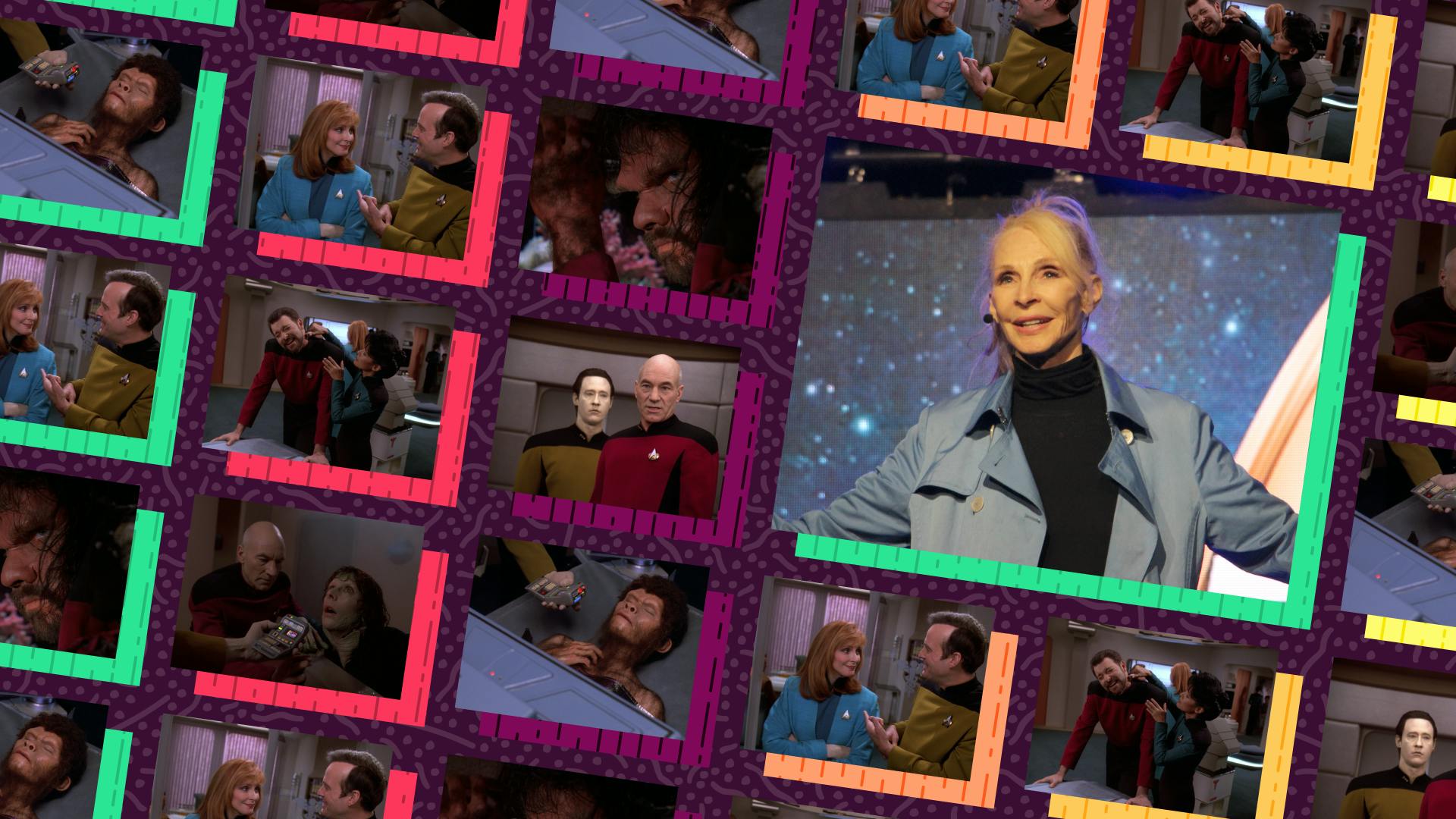

Related articles
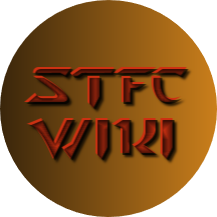
Augment Space
- View history
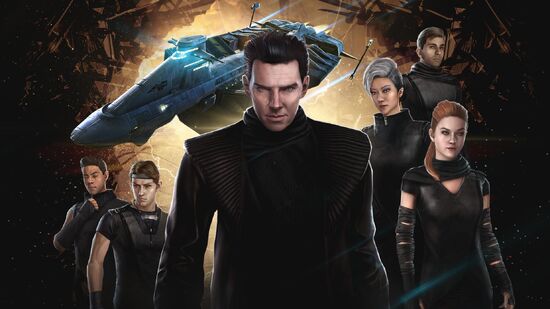
The New Augment Faction , see popular video's on the topic
- 1 Tips and Wiki Links
- 2 Augment Missions
- 3 Khan's Crew
- 4 Locations
- 5 Mining Tips
Tips and Wiki Links
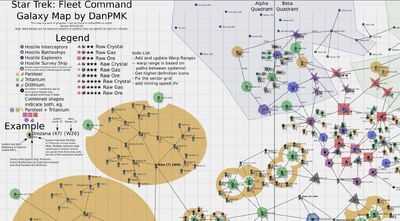
The new Augments' Botany Bay Ship
Mining the Data Resource
See the Link or click the preview image, for DanPMK's Map, then open image in a tab of its own to zoom or download. Updated for The Swarm and Augment Zones by [KENT] Aeetes.
What is the Vaaran Expanse
- Also known as Augment Space
- Vaara = Vaaran Expanse
- Augment Space is unlocked by building the Botany Bay Ship
Augment Missions
Khan's Crew
Credit for the extra Khan's Crew info goes to Capt Kaos with an excellent resource
Also see Data Resource and the Botany Bay pages.
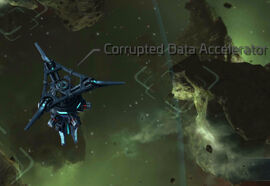

Mining Tips
Tip , as it gets more dangerous the higher reputation you get with the Augments, remember to mine there and not be hit: 1: Send a ship & closely after , your Botany Bay or other Mining Ship, once the 1st ship is targeted, set your Survey to mine the Data, then warp the 1st ship out before it's hit. Your Survey ship will be safe to mine thereafter. 2: Send your mining ship closely followed by another ship, once your Survey Ship is targeted by the Bounty Hunter Ship, simply attack it with your other ship, you are then safe to mine also toggle on and off to respawn the mine without being targeted again.
- 1 The Swarm
- 3 Faction Reputation
Star Trek: Enterprise (TV Series)
The augments (2004), full cast & crew.

Directed by
Writing credits , cast (in credits order) , produced by , music by , cinematography by , editing by , casting by , production design by , costume design by , makeup department , second unit director or assistant director , art department , sound department , special effects by , visual effects by , stunts , camera and electrical department , casting department , costume and wardrobe department , editorial department , music department , script and continuity department , transportation department , additional crew .
Release Dates | Official Sites | Company Credits | Filming & Production | Technical Specs
Contribute to This Page
- Full Cast and Crew
- Release Dates
- Official Sites
- Company Credits
- Filming & Production
- Technical Specs
- Plot Summary
- Plot Keywords
- Parents Guide
Did You Know?
- Crazy Credits
- Alternate Versions
- Connections
- Soundtracks
Photo & Video
- Photo Gallery
- Trailers and Videos
- User Reviews
- User Ratings
- External Reviews
- Metacritic Reviews
Related Items
- External Sites
Related lists from IMDb users

Recently Viewed
- VisualEditor
- View history
An augmented Human with no physical changes
Augments are genetically enhanced individuals who have had their genes deliberately altered for the purposes of giving them superior physical and/or mental abilities.
Physiology [ | ]
Augments vary according to the primary DNA used. They are typically given enhanced strength and often intellect. This can give them a greater stature and combat proficiency but can also lead to them being harder to control as superior ability breeds superior ambition.
Use of augmentation [ | ]
Federation [ | ].
The Federation has outlawed genetic engineering and it has historically been used by the Denobulans . The ban was prompted by humanity's disastrous use of augmentation during the 1990s and the subsequent fall-out that impacted as late as the 23rd century via the crew of the S.S. Botany Bay.
Despite the ban, illegal modification does occur. While it can be successful, though subjects such as Julian Bashir must keep the procedure a secret, others can face psychological damage from the procedure. Such individuals are supported via Project Chrysalis.
In the 25th century, the Federation Science Council has given Julian Bashir permission to test various forms of genetic modification to find treatments for degenerative diseases such as the Irumodic Syndrome .
Klingon Empire [ | ]
The Klingons experimented with genetic augmentation in the 22nd century. The experiments led to the Klingon augment virus deforming their appearance. Since then, they avoided the technology until the 25th Century when Amar Singh , a human scientist against the Federation's ban on augmentation, worked with the Klingons on H'atoria to develop Gorn hybrid augments for the Klingon war effort.
Aside from Klingon experiments, the Ferasans (who are part of the Klingon Empire by the 25th century) have been notable users of augmentation for the last 800 years. Their adoption of it led to a split in their race, with Caitians against its use and leaving.
Other Species [ | ]
The Dominion rely on genetic engineering for the creation of Jem'Hadar and Vorta . While they are augmented from existing species, they now bear little resemblance to their former selves.
The Suliban used genetic enhancements in the 22nd century as part of the Temporal Cold War , but have ceased the practice by the 25th century.
Missions involved [ | ]
Missions mentioned [ | ]
- Category:Augment NPCs
Duty officers [ | ]
- Elizabeth Mohr
- Goshi the Augmented
See also [ | ]
- Assignment chain: Caitian Diaspora
- Assignment chain: Unforgiven of Ferasa
- Assignment chain: Project Chrysalis
External links [ | ]
- Augment at Memory Alpha , the Star Trek Wiki.
- Augment at Memory Beta , the non-canon Star Trek Wiki.
- 1 Kirayoshi O'Brien
- 2 Playable starship

'Picard' Season 2 Was Re-Written For Being "Too Star Trek," Says EP
- Season 2 of Star Trek: Picard faced challenges due to filming during COVID and network feedback about the show being "too sci-fi," leading to significant rewrites.
- Season 2 of Picard originally included complex plots involving Romulans, time travel, Guinan's bar, and more.
- Fans are still hoping Terry Matalas will helm a Star Trek: Legacy spin-off series.
Season 3 of Star Trek: Picard is widely regarded as one of the best installments in the entire franchise. While the show's previous two seasons were praised for trying something new, they also have their drawbacks, holding 86% and 85% scores respectively on Rotten Tomatoes , compared to Season 3's 98% critic rating. During a Master Replicas Collectors Club Zoom chat (via TrekMovie ) Season 3 showrunner Terry Matalas was able to shed some light on why Season 2 — the most controversial of the three, with a 30% audience score on RT — in particular, fell short of what fans wanted from the series.
“There’s actually many, many different versions of Season 2," said Matalas. "I think you can kind of feel when you watch Season 2 that there’s a lot of different ideas here.” He's not wrong, Season 2 of Picard sent the titular former captain and the crew of La Sirena back to the 2020s, an idea Matalas suggested to save money following an expensive Season 1. Partially the machinations of Q ( John de Lancie ) and partly a Borg ploy to destroy Earth a la First Contact , Season 2 had a lot going on between plot lines dealing with the origin of augments, a new evolution of the Borg queen, the ethics of time travel and messing with your own history, and Jean Luc Picard's childhood trauma .
What Originally Happened in 'Star Trek: Picard' Season 2?
While Matalas didn't delve too deeply into which parts of Season 2 came after the rewrite he explained that they nearly had all of the episodes completed when Paramount gave them the feedback that it was "a bit too sci-fi." He said: “We wrote nine episodes at one point and the network was like, ‘No, we don’t really understand this, it’s a bit too sci-fi, it’s a bit too in- Star Trek .’ ” Some of the lost
Though Q and the time travel plot were part of Season 2 from "day one," there were other classic Star Trek plots that were nixed from the final product. Matalas said:
“There were Romulans—there was a whole thing. The idea was that Guinan’s bar was presented as a normal bar in Los Angeles, but if you knew the right thing to do, you could go into the back through the telephone phone booth and that was Rick’s Café, and it was a stopping point for all these different species that were actually there on Earth with a ‘Do not interfere’ thing happening. So you had a lot more Star Trek happening in the backdrop of it. Ultimately, the powers that be at that time were like, ‘This is too much.’ But there were some really good ideas there that were pretty cool.”
Matalas and a group of writers began working on Season 3 before Season 2 was finalized, and while COVID complications and rewrites may have hindered the cohesion between the two, Season 3 brought the show to a profoundly satisfying conclusion. While nothing has been announced yet, fans are still hoping Matalas will return to the world of Star Trek with a Picard spin-off series following Seven of Nine ( Jeri Ryan ) and Jack Crusher ( Ed Speleers ).
While we wait for more Star Trek news, you can watch all three seasons of Picard on Paramount+ now. The franchise returns to the small screen with Star Trek: Discovery 's fifth and final season on April 4.
Star Trek: Picard
Follow-up series to Star Trek: The Next Generation (1987) and Star Trek: Nemesis (2002) that centers on Jean-Luc Picard in the next chapter of his life.
Release Date January 23, 2020
Cast Patrick Stewart, Alison Pill, Santiago Cabrera, Michelle Hurd, Harry Treadaway
Main Genre Sci-Fi
Genres Sci-Fi
Rating TV-MA
Watch on Paramount+


Khan Noonien Singh (alternate reality)
- View history
Khan Noonien Singh (or simply Khan ) was the most prominent of the genetically-engineered Human Augments of the late- 20th century Eugenics Wars period on Earth . Many Augments were genocidal tyrants who conquered and killed in the name of order, with Khan and his kind being frozen in cryogenic sleep.
In the 23rd century , Khan was revived by Admiral Alexander Marcus to design weapons and ships to prepare for war against the Klingon Empire . He was given a new identity, that of John Harrison , an English Starfleet commander . Khan, however, rebelled, and after believing his crew had been killed, he began a one-man campaign against Starfleet. His crew of augments remained frozen and Khan struggled to save them during his campaign. After gaining his revenge on Admiral Marcus, he was later stopped by the crew of the USS Enterprise and returned to cryogenic sleep with his crew.
- 1.1 20th century origins
- 1.2 21st century temporal changes
- 1.3 23rd century return
- 2 Memorable quotes
- 3.1 Background information
- 3.2 Apocrypha
- 3.3 Reception
- 3.4 External link
Biography [ ]
20th century origins [ ].
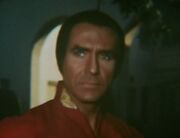
One of the few historic pictures of Khan from the 1990s
Records of the period, including Khan's origins, are vague. Khan was born, or created in 1959 . ( Star Trek Into Darkness ) He was the product of a selective breeding or genetic engineering program called Project Khan , based on the eugenic philosophy that held improving the capabilities of a man improved the entire Human race. Augments produced by the program possessed physical strength and analytical capabilities considerably superior to ordinary Humans, and were created from a variety of Earth's ethnic groups. Khan's background was suspected by McGivers to be Sikh , from the northern region of India . ( PIC : " Farewell "; TOS : " Space Seed ")
Khan lived up to the axiom coined by one of his creators, "superior ability breeds superior ambition". By 1993 , a wave of the genetic "supermen," including Khan, had simultaneously assumed control of more than forty of Earth's nations. From 1992 to 1996 , Khan was absolute ruler of more than one-quarter of Earth's population, including regions of Asia and the Middle East . Considered "the best of tyrants "; Khan's reign was considered the most benevolent. His regime was free of much of the problems that plagued Earth history of that era – as Khan was never known for engaging in massacres, genocide or wars of aggression. However, the citizens of his regime enjoyed little freedom. Khan had little, if any, respect for individual liberty, which was also a key issue for Earth history. As such, personal initiative and financial investment were low, and scientific progress suffered as a result.
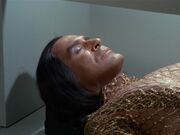
Khan aboard the Botany Bay
In the mid- 1990s , the Augment tyrants began warring among themselves. Other nations joined in, to force them from power , in a series of struggles that became known as the Eugenics Wars . Eventually, most of the tyrants were defeated and their territory recaptured, but up to ninety "supermen" were never accounted for.
Khan escaped the wars and their consequences along with eighty-four followers, who swore to live and die at his command. He saw his best option in a risky, self-imposed exile. In 1996 , he took control of a DY-100-class interplanetary sleeper ship he christened SS Botany Bay , named for the site of the Australian penal colony . Set on a course outbound from the solar system but with no apparent destination in mind, Khan and his people remained in suspended animation for Botany Bay 's centuries-long sublight journey. ( TOS : " Space Seed "; Star Trek Into Darkness )
21st century temporal changes [ ]

Khan as a child in 2022
Due to the changes caused in the timeline as a result of various Temporal Wars , the original events concerning the rise of Singh were pushed back, and events reinserted themselves at a later date in the timeline. According to Romulan temporal agent Sera , in a revised 2022 timeline, " And all this was supposed to happen back in 1992, and I've been trapped here for 30 years trying to get my shot at [Khan]. "
The Khan of this era lived in Toronto , Ontario , Canada , at the Noonien-Singh Institute for Cultural Advancement .
As a child in the revised timeline, he witnessed La'an Noonien-Singh shoot and wound Sera, his would-be assassin . La'an entered Khan's room and found her infamous ancestor cowering behind his bed. When Khan asked if she was going to kill him, she looked at the gun and sat it on the desk next to the bed. La'an assured him that she would not hurt him, as she proceeded to wipe Romulan blood from his face. Curious, La'an asked if he was alone, or if there were others like him. Khan gestured to a photograph on the wall of himself and six other children. He then asked if she was going to take him away. La'an told him that it may not make sense to him, then or maybe ever, but he was where he needed to be. She walked to the entrance of the room, activated the temporal transporter device in front of Khan, and returned to her own time period.
Khan’s legacy in the altered timeline was a history of torture, genocide, and his descendants.
In an alternate timeline , which was created from the revised timeline, Sera successfully assassinated Khan by blowing up a nearby fusion reactor (also destroying Toronto ) after a Federation Department of Temporal Investigations agent was shot and failed to protect Khan. As a result, a dark future for Humanity emerged in which Earth was nearly uninhabitable, Starfleet and Federation never formed, and the Romulan Star Empire was the dominant force of the region.
This timeline was averted after Khan's descendant, La'an, encountered the temporal agent aboard the USS Enterprise who directed her to return to the past, and with the help of James Kirk , from the, now, alternate timeline. The two time traveled to the past and La'an stopped Khan's assassination and restored the timeline to as she knew it. ( SNW : " Tomorrow and Tomorrow and Tomorrow ")
23rd century return [ ]

Khan's false ID "John Harrison"
Following the destruction of Vulcan in 2258 , Admiral Alexander Marcus of Section 31 initiated a program to militarize Starfleet and began searching the galaxy for weapons to be used in the war with the Klingon Empire that he now believed was inevitable. Soon after, he discovered the SS Botany Bay adrift.
Despite knowing Khan's history, Marcus decided to bring him out of cryogenic suspension, believing his savagery and superior intellect would be prime assets to his cause. Having his voice and physical appearance heavily altered, Khan was reawakened and recruited under the identity of Section 31 agent, "John Harrison". Marcus forced Khan into working with him by threatening to kill his fellow Augments, and set him to work designing weapons and ships for Starfleet, including the Dreadnought -class USS Vengeance .
Disgruntled, Khan tried to smuggle his crew away in advanced long-range torpedoes but was discovered and forced to flee alone. Believing Marcus had killed his crew, he coerced Section 31 agent Thomas Harewood into betraying Starfleet by offering a blood transfusion for Harewood's terminally-ill daughter . Harewood agreed, and Khan replaced his Starfleet Academy ring with a bomb .
After his daughter was cured with a vial of Khan's blood and its regenerative platelets , Harewood went to work at his office in the Kelvin Memorial Archive in London , where he dropped the false Starfleet ring into a glass of water, igniting the bomb and destroying the facility. In the midst of the chaos, Khan used the opportunity to inspect a salvaged terminal to gain the confiscated formula for transwarp beaming .

Harrison piloting Jumpship 208
Before he set off the explosion, Harewood sent Marcus a message, explaining he had been threatened by Khan. Knowing that Marcus would call an emergency meeting in the light of the bombing, Khan rigged a combat efficient jumpship with a portable transwarp beaming device and headed to the Daystrom Conference Room . As the conference was underway, Khan appeared and laid waste to the conference, killing Admiral Pike , Captain Abbott and many other high ranking Starfleet officers. James T. Kirk disabled the jumpship , but Khan beamed himself away before it crashed. He arrived in the one place Starfleet could not go: Qo'noS , the Klingon homeworld.
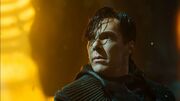
"John Harrison" reveals himself on Qo'noS
Undeterred, Kirk was granted permission by Marcus to travel to Qo'noS and fire 72 experimental photon torpedoes on Khan's location. However, at the behest of his crew, Kirk chose to defy his orders and opted to arrest Khan instead. While Kirk led an away team with Spock , Uhura , and Hendorff , acting captain Sulu transmitted a message to Khan, warning him to surrender or be destroyed by the newly designed shipboard torpedoes.
Suspecting the newly designed torpedoes were the very torpedoes he smuggled his crew into, Khan sought out the away team to confirm. Khan found Kirk, Spock, and Uhura being attacked by a Klingon patrol and single-handedly killed dozens of Klingons . Confronting the landing party , Khan asked how many torpedoes the USS Enterprise had on board. Spock informed him of the count, which corresponded exactly to the number of his former crew members which were still in stasis. Khan then surrendered to the landing party. Kirk, angry that his mentor's murderer had saved them, punched Khan repeatedly but was unable to render him unconscious.

Khan in custody
From the brig , Leonard McCoy took a blood sample to analyze the secret behind Khan's superhuman strength and abilities and injected it into a dead tribble . Khan refused to answer Kirk's questions; he instead gave him coordinates to the spacedock near Jupiter where the Vengeance was constructed, and suggested he open one of the experimental torpedoes.
Kirk gave the coordinates for the absent Montgomery Scott to investigate, while McCoy and Marcus's daughter Carol opened up a torpedo and discovered a cryogenically frozen man within and realized that he was 300 years old. Khan finally explained who he was to Kirk, and revealed that the torpedoes contained his fellow surviving Augments as part of a cover-up.
Marcus appeared in the Vengeance and demanded Kirk hand over Khan. Kirk refused, and the Enterprise warped back to Earth with the intent of putting Khan on trial, which would certainly expose Marcus in the conspiracy. As Khan predicted, Vengeance caught up in subspace and fired on the Enterprise as it arrived outside Earth.

Kirk and Khan team up
Marcus beamed his daughter over to the Vengeance and prepared to destroy the Enterprise but Scott, who had snuck aboard the Vengeance at its spacedock, deactivated its weapons. Kirk and Khan donned thruster suits to fly over and commandeer the Vengeance .
Meanwhile, Spock consulted his older counterpart from another timeline regarding whether he ever encountered Khan Noonien Singh : the old Spock responded he had, that he was dangerous, and that it had required a great sacrifice to stop him. Kirk had also grown suspicious of Khan and advised Scott to stun him after they had taken over the bridge of the Vengeance .
When they arrived on the bridge, Scott stunned Khan while Kirk admonished Marcus for compromising the Federation. However, Scott's phaser stun only temporarily subdued Khan, who quickly recovered and flung himself at Scott and Kirk, overpowered them, then stomping upon Carol's leg. Khan then used his bare hands to crush Marcus's skull, extracting revenge on his once tormentor.
Khan then sat in the command chair and ordered Spock to hand over the torpedoes or he would kill Kirk and resume bombarding the Enterprise . Spock obliged, and Khan beamed Kirk, Scott and Carol back into the Enterprise 's brig, but reneged on the deal. Spock, having predicted Khan's betrayal, had ordered McCoy to remove the stasis pods and detonated the torpedoes after they were beamed over, crippling the Vengeance before she could destroy the Enterprise . Khan cried out in anguish at the apparent loss of his crew.

Khan sets the Vengeance on a course with the heart of Starfleet
The damage sustained caused both ships to be drawn by Earth's gravitational pull. To prevent the ship crashing into western North America, Kirk sacrificed himself reactivating the ship's warp core . Khan, on the other hand, directed the Vengeance on a crash course for Starfleet Headquarters , though the computer could not guarantee that Khan would make it.
The Vengeance slammed into the old prison on Alcatraz Island, careened across San Francisco Bay , and then plowed into several buildings, demolishing several skyscrapers. When the Vengeance crashed into the city, Khan leapt off the bridge and posed as a shocked survivor. Spock beamed down to execute Khan and avenge Kirk's death, pursuing him onto automated flying barges. In the Enterprise 's medbay , McCoy had just examined Kirk's body when the dead tribble on his desk came back to life.

Khan in stasis following his defeat
The fight took the two combatants on to two automated barges. Spock had the advantage of creativity, and extensive knowledge of martial arts, but Khan had the superior advantages of superhuman strength, speed, thought and durability. Spock attempted to subdue Khan with a nerve pinch but Khan managed to overcome the pain.
As Khan attempted to use his bare hands to crush Spock's skull, Spock managed to counter it with a mind meld . Near the end of the melee, with Spock again in Khan's cranial crushing lock, Uhura beamed down and fired several stun shots to distract Khan. Spock tore a piece of metal from the barge and broke Khan's arm. Spock started repeatedly pummeling Khan, coming very close to killing him, Fortunately, Uhura revealed Khan's blood could save Kirk, and Spock just knocked him out.
After his blood was used to revive Kirk, Khan was placed back in suspended animation with his crew from the Botany Bay . ( Star Trek Into Darkness )
The geneticist Arik Soong believed Augments like Khan could be created without exhibiting his more vicious, psychopathic or megalomaniacal instincts. Soong's "children", created from Augment embryos stolen in 2134 , failed to live up to the hopes of their "father". Soong believed Khan and the Botany Bay to be nothing more than a myth, although his "children" believed differently. ( ENT : " Borderland ", " The Augments ")
Memorable quotes [ ]
" I can save her. " " What did you say? " " Your daughter, I can save her. "
" Captain, are you going to punch me again, over and over, until your arm weakens? Clearly you want to. "
" John Harrison was a fiction created the moment I was awoken by your Admiral Marcus to help him advance his cause. A smoke screen to conceal my true identity. My name… is Khan . "
" Why would a Starfleet Admiral ask a three-hundred year-old frozen man for help? " " Because I am better. " " At what? " " Everything. "
" Alexander Marcus needed to respond to an uncivilized threat in a civilized time, and for that, he needed a warrior's mind – my mind – to design weapons and warships. " " You are suggesting the Admiral violated every regulation he vowed to uphold, simply because he wanted to exploit your intellect. " " He wanted to exploit my savagery! Intellect alone is useless in a fight, Mr. Spock. You, you can't even break a rule; how can you be expected to break bone? "
" My crew… is my family, Kirk. Is there anything you would not do… for your family?"
" You… You should have let me sleep! "
Appendices [ ]
Background information [ ].
Bringing back Khan Noonien Singh was discussed before the release of Star Trek ; on the film's audio commentary , it is stated the filmmakers considered having a shot of the SS Botany Bay after the credits, but opted out in case they decided not to use the character. Director J.J. Abrams said, " It'll be fun to hear what Alex and Bob are thinking about Khan. The fun of this timeline is arguing that different stories, with the same characters, could be equally if not more compelling than what's been told before […] Certain people are destined to cross paths and come together, and Khan is out there… even if he doesn't have the same issues. " [1]
Co-writer Damon Lindelof said the jumping-off point for the sequel's story was deciding whether Khan would be the villain, and he, Kurtzman and Orci weighed the pros and cons of using the character. [2] Abrams commented that, in comparison to Nero from Star Trek , the writers wanted "a much more nuanced and complex villain" for Into Darkness . ( Cinefex , No. 134, p. 72) Due to the massive popularity of how Khan had been represented before, however, "there was a good year of debate," explained Alex Kurtzman, over whether to include Khan in the upcoming movie. With a laugh, Orci phrased this issue, " To Khan or not to Khan. " Kurtzman observed, " The choice to play in that sandbox is really complicated because when a character was as beloved as Khan, you really have to have a reason to do it. " [3] During the debate, Lindelof wanted to use Khan, while Orci was against this option.
The filmmakers found a compromise by developing a story that would not entail Khan, and then determining if he could be "reverse engineered" into it. [4] Stated Kurtzman, " If we could take that [tale] and then incorporate Khan into the mix in a way that felt reverent and appropriate for that story, we would do it. Without that standard, we wouldn't […] We all loved the 'Space Seed' back story, the idea that he was a man who loved his crew as his family – that was the understandable and relatable agenda. And then we built outward from there. " [5] Eventually, Orci felt " the details became too juicy to avoid. Genetic super man from a time that understood war and savagery, etc. Once we had a basic structure that did not necessarily necessitate him, we were able to tailor the script itself to details and inspirations that he brought. " [6] Lindelof added the story-line avoided " The audience [knowing] something the bridge crew did not, which was 'Whatever you do, don’t wake that dude up.' So we didn't want to put the bridge crew behind the audience in terms of what they knew about Trek . " [7]
Khan's undercover name was inspired by his name in an early draft of the script for " Space Seed ", John Ericssen. Orci said, " We shot the movie using the name Ericsenn [sic] but decided it would give it away[,] so we cheated the name Harrison into everyone's mouth! " [8] According to John Eaves , the character's production code-name was April , another character Orci said he had considered as a villain. [9] [10] Once they chose to bring Khan into their film, the screenwriters were not necessarily eager to additionally incorporate a moment when the character's name is shouted in anger, as happens in Star Trek II: The Wrath of Khan , because they considered it vital that such a reaction be a natural and realistic one. [11]
Khan was portrayed by Benedict Cumberbatch . Before he was cast, Abrams approached Benicio del Toro for the role. [12] There were some complaints, particuarly from the Sikh community, over casting a white actor for a role of a Indian Sikh. [13] [14] [15] Orci said they shied away from casting an Asian actor as Khan because " it became uncomfortable for me to support demonizing anyone of color, particularly any one of middle eastern descent or anyone evoking that. One of the points of the movie is that we must be careful about the villain within US, not some other race. " He also stated the "true essence" of Khan's character was "that he was a genetically engineered superman," "not where he was from or the color of his skin." [16] In response to a question asking whether Khan's appearance was "cosmetically altered to avoid detection," Orci said that the theory was an "interesting idea. Could be." [17] Also, in answer to a question about Khan's change in features, Orci stated, " Uhm… one of his abilities is that he is a shape shifter? " [18]
Cumberbatch commented the role was "daunting because of the legacy involved and the amount of speculation about [Khan] possibly being the villain." ( Empire issue 289, p. 23) Lindelof said of writing for Cumberbatch that " when you can get [a] monologue to come out of [his] mouth, does the 'writing' even matter? I mean, seriously, I made that guy say 'Milk, milk lemonade, and this is where the fudge is made' and it scared the living shit out of me. " [19]
Cumberbatch was cast two weeks before filming. Mary L. Mastro , head of the film's hair department, wanted Khan to have black hair to contrast with the blond Kirk. She recalled, " JJ called a meeting with the creators involved in what he was going to look like and [Cumberbatch] walks into the room with super-short blond hair. My mouth dropped open, like, 'Oh, great.' " The schedule was altered slightly to give more time to determine Cumberbatch's appearance in the film. [20] The filmmakers considered giving Cumberbatch a shoulder-length wig, but Abrams felt he looked better without it. ( Star Trek Into Darkness iTunes enhanced commentary) Costume Designer Michael Kaplan wanted Khan to be "dapper," giving him " a number of very long, elegant coats. It's nice, even in the distance, to be able to recognise a character right away. He's pretty high fashion-looking. "
Cumberbatch trained one-to-one with his stunt double, Martin De Boer , learning basic martial arts. De Boer described Cumberbatch as "'very receptive to learning. I've had actors who want to be an action star but don't want to put in the work, and he was the opposite, he said, "'I want to train as much as I can.' He was very committed. Besides working with us, he was working with his personal trainer five, six days a week; he really got in shape." De Boer said that, because of Khan's strength, Cumberbatch "wanted to have more static and powerful movements. That strength changes the rules of the martial arts we use. You don't have to do five punches, you just have to use a couple of moves and he takes out the guy already." [21]
Bad Robot Productions went to great lengths to hide Khan's identity, even screening the space jump scene to the press with life sign readouts displayed as "Harrison" and Spock's lines referring to Khan overdubbed to refer to Harrison. Bryan Burk defended the strategy, stating, " Even if you don't even know who Khan is, you know that you're watching a film where for forty-five minutes or an hour of the movie you are ahead of the characters. So you're just kind of waiting for them to catch up with what you already know, that he is not who he says he is. " [22] Cumberbatch said the secrecy was fine for him, though Alice Eve did tease him, saying, " The lies, Benedict, the lies! " Recalling times when he had sneaked into screenings to see the audience's reaction to Khan revealing himself, Cumberbatch remarked that "to have that moment – that's worth any amount of subterfuge or holding back on reveals." ( Empire issue 289, p. 23)
The creative staff were ultimately very pleased with how Khan is depicted in Into Darkness . " Ultimately, I think we felt that we found a reason and a way to do it that was all of the things we needed it to be, and yet really different, " voiced Kurtzman. "I think the mistake that we could have made, that we didn't want to make, was to do a version of what Ricardo Montalban had done so brilliantly, and then fall short of that […] There are things about Khan that are very familiar, and there are things that are entirely different, and that's exactly what we wanted to do. " [23]
However, Abrams voiced regret over keeping Khan's identity a secret. " The truth is I think it probably would have been smarter just to say upfront 'This is who it is.' It was only trying to preserve the fun of it, and it might have given more time to acclimate and accept that's what the thing was, " he said. He added that hiding Khan's presence was mandated by the studio, who did not want to alienate non- Star Trek fans with the impression they had to learn about who Khan was to enjoy the film. Abrams agreed with that notion but " wonder[ed] if it would have seemed a little bit less like an attempt at deception if we had just come out with it. " [24] Responding to Burk's comment that it might have hurt the film if the audience knew Harrison was Khan before Kirk did, Abrams added "the truth is it probably wouldn't have made much of a difference in that regard." [25]
When asked if Cumberbatch could reprise the role, Lindelof replied, " To answer that question would be to determine whether or not he actually survives this movie, but if he survives this movie, we would be incredibly stupid to not use him again. " [26] As to whether Khan's blood could disrupt dramatic tension in the next film, Orci said they "figured there are so many horrible ways to die in space that no medicine could save you from that we would be okay." [27]
In the Star Trek Encyclopedia (4th ed., vol. 1, p. 411), the authors considered it possible that the red matter -created black hole caused differences in the past from the Prime Timeline. On page 414 of volume 1, this is the information on the Khan of " Space Seed " and Star Trek II: The Wrath of Khan :
- Brilliant, charismatic, and extremely aggressive, Khan was a genetically engineered human who attempted to gain control of the entire planet Earth in the 1990s during the Eugenics Wars. From 1992 to 1996, Khan was absolute ruler of more than a quarter of Earth, from South Asia through the Middle East. He was the last of the tyrants to be overthrown. Khan escaped in 1996 aboard the sleeper ship S.S. Botany Bay .
On the following page, this is the information on the Khan of Star Trek: Into Darkness:
- In the Kelvin Timeline, Khan Noonien Singh was the brilliant, ruthless leader of a group of genetically engineered humans, or Augments, who nearly conquered Earth during the 20th-century Eugenics Wars. Khan attempted to commit genocide of those whom he deemed inferior, that is, most of Earth's population. Khan and his people were condemned as criminals, placed into cryogenic sleep in cryo tubes , and exiled aboard a ship sent into space.
Apocrypha [ ]
Cumberbatch also portrayed Khan/Harrison in three "Disruptions" videos to promote the film, in which he analyzes Kirk, Spock, and Uhura's weaknesses and declares he will threaten them. [28]
According to his biography on the Star Trek movie app, "John Harrison" was born in 2228 in Dover , Great Britain , Earth to Richard and Sara Harrison. Harrison was one of nine survivors of the attack on the colony on Tarsus IV in 2246 , and both of his parents were killed in the attack. He graduated from the London School of Economics in 2250 .
After graduating, he was appointed associate researcher, Starfleet Data Archive (London), East Annex in 2255. He was tasked with collection, organization and analysis of declassified data received from Starfleet-commissioned starships and from Federation member states.
The 2013 virtual collectible card battle game Star Trek: Rivals uses two cards showing Khan: #105, titled Commander J. Harrison, and card #111, titled Human Augment Khan.
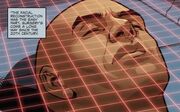
Khan, undergoing reconstructive surgery
The comic book series Star Trek: Khan begins after Khan's capture and him being brought to trial before the Federation Court and establishing his history subsequent to the divergence of the timeline but prior to his encounter with the Enterprise . The Section 31 starship USS Vanguard discovered the Botany Bay drifting in space and take custody of Khan. Quickly using their databanks to determine his identity prior to awakening him, Admiral Marcus orders that Khan's face and voice be reconstructed from their Indian origins to a more northern European origin and has his memory blocked with the intent of convincing Khan that he is John Harrison, a Starfleet researcher in London's Kelvin Memorial Archive who lost his memories in an accident during a failed mission to Qo'noS.
He is given the task of helping advise Section 31 on possible enhancements to Starfleet weapon, shield and propulsion technology (which is to be incorporated aboard the USS Vengeance ) as well as taking on a mission to destroy Praxis with the help of a portable transporter he designed and built. The mission is a success (explaining the destroyed moon seen in orbit of the Klingon homeworld in the film), but in the process, Khan rediscovers his memories of his true identity.
Discovering that his crew is being held in the London facility and forging transmissions from Marcus, Khan is able to load his crew into the long-range torpedoes with the intent of stealing a starship with them aboard, but before departing, Khan invades Marcus' home and demanded to know the truth before planning to kill him. The admiral, planning for Khan's rediscovery, has him targeted by a jumpship outside the window, forcing Khan to flee. His plan, now circumvented, forces him to coerce Thomas Harewood into destroying the London facility and set the events of the film into motion.
Star Trek: Khan also establishes that he was originally an ordinary Indian boy named Noonien Singh and was an orphan living in an impoverished New Delhi slum. In 1972, he was captured, along with other impoverished children, and taken to a research facility to be a test subject for genetic engineering experiments. In August 1985, as a young man, he escaped from the research facility, along with the other genetically engineered test subjects, and began a rebellion. He later gives himself the title of "Khan", out of admiration for historical Mongol conqueror Genghis Khan , naming himself "Khan Noonien Singh".
By the end of series however, doubt is cast about how much of the events depicted in Khan's backstory is in fact truthful. Given the fact that his backstory is mostly only conveyed through what Khan tells the Court, Kirk points out that it is entirely within Khan's best interests to paint an overall sympathetic story of himself rather than simply disclosing a factual retelling of his actual past. Khan was then placed back into stasis, with Kirk noting that despite everything, Khan had managed to get exactly what he wanted.
In the second issue of the Star Trek: Ongoing story arc The Khitomer Conflict , it was established that Khan and the other Augments were stored at a top-secret facility on an asteroid , with the location of the facility highly classified to the point that even Kirk himself didn't know where they were held.

Khan's female counterpart
Like the rest of the characters in the parallel universe of Parallel Lives, Part 1 and Part 2 , he has a female counterpart ( β ).
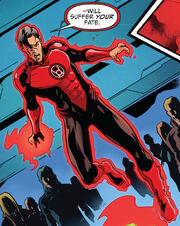
Khan as a Red Lantern
Khan returned in the comic crossover mini-series Star Trek - Green Lantern: Stranger Worlds , where he serves as one of the primary antagonists. In 2262 , the Red Lantern Atrocitus needed to find a source of rage to recharge his Power Ring and his journey lead to him to discover the asteroid facility where Khan and the other Augments were locked away. He then broke into the facility and begun freeing them, including Khan. However, Khan overpowered the alien and knocked him out while also taking possession of his ring. Before he could slay his foe, he was confronted by Green Lanterns Kilowog , Guy Gardner and John Stewart . After Gardner revealed that the ring was loyal only to Atrocitus, Khan crushed the alien with his foot and he became the ring's new bearer, using his rage to easily defeat his new foes. After explaining his new appearance to his troops, Khan led his men to seize control of the USS Bryant where he once again encountered Kirk and Spock. Though Hal Jordan tried to fight Khan, the Augment managed to best him as well, but his boasting left him open to an attack from the other Lanterns and a photon torpedo barrage from the Enterprise . Defeated, Khan used his ring to recharge the Bryant and make his escape. Making his way to Qo'noS, Khan overthrew Orange Lantern Larfleeze and bargained with the Klingon High Council to aid him in attaining the power of the planet Oa and use it to conquer the Federation. Using his ring to supercharge the Klingon warships, Khan followed Kirk to Oa, only for the captain to be chosen by a Green Lantern Power Ring before the Augment could slay his foe. As the fighting intensified, the Augments were all defeated, depriving Khan of his power. Though he attempted to goad Kirk into slaying him, Kirk stuck to his morals and simply knocked Khan out and returned him to prison while Khan's ring was seized by the Enterprise crew for study.
Reception [ ]
Entertainment Weekly saw parallels between the new Khan and figures such as Osama Bin Laden or Saddam Hussein , as both men were allied with the US before turning on them. [29] Simon Pegg commented " Iraq had nothing proven to do with 9/11 , and yet Bush used that as an excuse to start a war with those people. You can always see the Klingons as like Iraq and John Harrison the proxy for Osama bin Laden. " [30]
Lindelof further acknowledged the terrorism parallels in an interview with StarTrek.com , as Khan's 72 torpedoes reminded them of the notion of 72 virgins in paradise. Lindelof responded " Of course it is a coincidence, because that is a number taken from canon. It was pointed out to us at the scripting phase – the 72 virgins – and that actually gave us pause, because we didn't want people drawing that comparison… but there it is. " [31]
The New Yorker also saw parallels between the debate to execute or arrest Khan with that of the issue of targeted killing . [32]
External link [ ]
- Khan Noonien Singh (Kelvin timeline) at Memory Beta , the wiki for licensed Star Trek works
- 2 Star Trek: The Next Generation
- 3 USS Enterprise (NCC-1701-G)
Screen Rant
Brent spiner didn’t leave star trek: tng because data is “an unlimited character”.
Playing Data on Star Trek: The Next Generation gave actor Brent Spiner the opportunity to take on many different kinds of characters.
- Playing Data allowed Brent Spiner to showcase his range by embodying various characters beyond the android, including personalities taken over by alien beings.
- Even with the challenge of portraying an emotionless character, Spiner brought heart and nuance to Data, prompting questions about his true emotional capacity.
- Post-TNG, Spiner continued his Star Trek journey by portraying multiple characters in the Soong family, demonstrating the unlimited potential of Data's character.
Brent Spiner has been playing the android Data on and off since the character debuted in Star Trek: The Next Generation in 1987, and he has always enjoyed the versatility of the role. TNG followed the adventures of the USS Enterprise-D and its crew as they explored the galaxy, and Data's journey to learn more about humanity became one of the show's most successful storylines. By observing Captain Jean-Luc Picard (Patrick Stewart) and the others around him, Data did his best to emulate humans and became more and more human as the show progressed.
While Data may have seemed like an emotionless android on paper, Brent Spiner brought a lot of heart to the role, making Data's characterization much more nuanced. Spiner also got to show his range as an actor on numerous occasions, not only by playing characters other than Data , including Data's creator Dr. Noonien Soong, but also by playing different versions of Data. Data's mind was overtaken by alien beings on multiple occasions, all of whom had very different personalities from the android. But even when Data was himself, he still expressed feelings in his own way, often prompting his friends to question whether he was truly without emotion.
Data's 10 Best TNG & Star Trek Picard Episodes
Why brent spiner saw star trek: tng’s data as “an unlimited character”, data gave spiner the chance to play many different characters throughout tng..
Brent Spiner loved that he got to play so many different characters beyond Data throughout his time on Star Trek: The Next Generation . In The Center Seat by Peter Holmstrom, the companion book to The Nacelle Company's documentary series, Spiner spoke about what made Data "a dream part." Read his full quote below:
It was a dream part. I got to play so many characters on the show. Not just Lore and Dr. Soong, but there were shows that I would play three, four, five characters in. They were always throwing really interesting challenges my way, and keeping it interesting for me. We had a director somewhere around the third episode who said to me, 'If this goes seven years you’re going to want to blow your brains out. How can you play this non-emotional character for seven years?' I said, 'I don’t know. I don’t see it that way. I don't think that it’s limited. I think it’s an unlimited character.' Fortunately, I sort of turned out to be right on that.
With the far future setting of TNG , the possibilities were endless for the show to include all manner of alien species, many of whom could possess humanoid beings. On multiple occasions, Data was overtaken by another personality, allowing Brent Spiner to play more expressive characters than the Enterprise's resident android . From the memories of Data's "grandpa" in "The Schizoid Man" to the personality of a dangerous prisoner in "Power Play" to the various cultural figures in "Masks," Data was not always himself. But even when Data was just Data, Spiner found ways to show the android's version of emotion, in his friendships and adventures on the holodeck, among other things.
Brent Spiner played Data's evil twin brother, Lore, in TNG , as well as the Soong prototype android B-4 in Star Trek: Nemesis .
Brent Spiner Played Even More Star Trek Characters After TNG
Spiner has played several soong androids and members of the soong family..
After the conclusion of Star Trek: The Next Generation and its subsequent films, Brent Spiner remained a fixture in Star Trek, playing many characters beyond Data. In TNG , Spiner had played Data's creator Dr. Noonien Soong, as well as Data's evil twin brother, Lore, and he went on to play many other members of the Soong family . In Star Trek: Enterprise season 4, Spiner played Arik Soong, a geneticist working on augmented humans. After his augment "children" turned violent, Arik began pursuing cybernetics, which would prove to be a significantly more fruitful endeavor for the Soongs.
Brent Spiner portrayed Dr. Noonien Soong's son, Altan Inigo Soong, in Star Trek: Picard season 1, who was continuing his father's work on synthetic life. In Picard season 2, Spiner took on the role of Dr. Adam Soong, a geneticist from the 21st century who became obsessed with his own legacy. Spiner finally got to resurrect Data and Lore in Picard season 3 , as both androids' personalities were incorporated into the newly upgraded android known as Data. In the end, Brent Spiner was right about how versatile the role of Data would become, both during and after Star Trek: The Next Generation.
Source: The Center Seat: 55 Years Of Star Trek by Peter Holmstrom
Star Trek: The Next Generation

COMMENTS
The term augment was used to describe a group of genetically-engineered Humans created by advances in DNA resequencing in the late 20th century.In the 22nd century, Klingons created their own Augments using the original augmented Human DNA. Analogous terms included superhuman and superman.(Star Trek Into Darkness; TOS: "Space Seed"; DS9: "Doctor Bashir, I Presume", "The Sound of Her Voice") In ...
The Augments. " The Augments " is the sixth episode of the fourth season of the American science fiction television series Star Trek: Enterprise, the eighty-second episode overall. It is the last of a three-story episode arc, preceded by "Borderland", and "Cold Station 12". "The Augments" was directed by LeVar Burton, from a script by Michael ...
Genetic augmentation is illegal in the Star Trek universe, and the superhuman powers displayed by Khan Noonien Singh (Ricardo Montalban) and his fellow Augments is a good example of why those laws exist. Star Trek: The Original Series first introduced the concept of the Augments in the classic episode "Space Seed", which introduced Khan as the future nemesis of Captain James T. Kirk (William ...
By raising the Augments himself, Soong believed he could prevent them from behaving like their brethren from the Eugenics Wars. His plan failed as the aggressive nature of the Augments dominated, and they threatened to incite war and cause mass murder. ... Both "Space Seed" and Star Trek II: The Wrath of Khan give the dating of the Eugenics ...
Dr. Soong's Augments acquire additional Augment embryos as well as biological weapons from Cold Station 12. A desperate plan is devised to use the biological weapons to foment a war between the Klingons and Earth in an attempt to flee Earth's control forever.(Part 3 of 3) Captain Jonathan Archer has just reached the primary junction in the central core of Cold Station 12. The captain has forty ...
Augment, in the general sense, is the designation given to a person or group that has been biologically altered to be physically and/or mentally superior to their base species. In more specific usage, the term "Augments" is applied to the genetically-enhanced "supermen" of Earth's Eugenics Wars, and to similarly-altered humans in the centuries after. The origins of the Augments were said to ...
"Trek" history is a little fuzzy on the subject of whether the subsequent Eugenics Wars were fought between the Augments themselves, or by ordinary humans looking to overthrow their GM overlords.
Warning: SPOILERS for Star Trek: Prodigy Season 1's Finale - "Supernova, Part 2" The season 1 finale of Star Trek: Prodigy opened up a brighter future for genetically-engineered Augments, continuing what began with Dr. Julian Bashir (Alexander Siddig) on Star Trek: Deep Space Nine.Bashir was discovered to be genetically engineered in DS9 season 5, and he nearly lost his Starfleet career ...
An action-adventure drama about the escape of the Augments, genetically enhanced humans, from a Klingon colony. The episode is part of a three-part story arc that explores the ethical and moral dilemmas of genetic engineering.
This week's episode of Star Trek: Strange New Worlds brings to trial Una Chin-Riley's status as an Augment. From Khan Noonien Singh to Dr. Julian Bashir to Dal R'El, there have been several genetically-enhanced characters throughout Star Trek 's history, which we dive into in this clip from the most recent segment of The Ready Room.
The Augment Crisis ("Borderland," "Cold Station 12," and "The Augments") "Cold Station 12" StarTrek.com. ... Star Trek: Discovery Seasons 1 through 4 are currently streaming exclusively on Paramount+ in the U.S., the UK, Switzerland, South Korea, Latin America, Germany, France, Italy, Australia and Austria. Seasons two and three also are ...
Warning: SPOILERS for Star Trek: Prodigy Season 1, Episode 18 - "Mindwalk" Dal R'El (Brett Gray) is the most evolved Augment Star Trek has ever seen, and Star Trek: Prodigy's teenage Captain is far superior to Khan Noonien Singh (Ricardo Montalbán). Dal discovered he was genetically engineered when the USS Protostar's teenage crew visited the laboratory of Dr. Jago (Amy Hill) in the Romulan ...
The Augments Of Star Trek Explained We explain the history of Star Trek's Augments. By Chris Snellgrove | Updated 8 months ago. Recently, the Star Trek prequel show Strange New Worlds made Augments the center focus of the franchise in a big way. However, these episodes didn't exactly make it clear to newer fans exactly what the Augments are and why they have been such a big deal in this ...
Khan Noonien Singh (or simply Khan) was an extremely intelligent and dangerous superhuman.He was the most prominent of the genetically-engineered Human Augments of the Eugenics Wars period on Earth.Khan was considered, by the USS Enterprise command crew, over three centuries later, to have been "the best" of them. Reappearing with a cadre of Augment followers in the 23rd century, Khan became a ...
In Star Trek II: The Wrath of Khan, audiences learn a natural space disaster changed the planet's climate, making it inhospitable. Khan and the rest of the augments died in a fruitless quest for ...
The Augment Faction is positive-only, meaning it's impossible to lose reputation depending on your actions. You can acquire Augment Reputation by completing Missions and events, or purchasing the corresponding packs in the Augment Faction Store. The Augment Faction store is where you can purchase Augment Tokens, Common - Rare Plutonium (Needed ...
The New Augment Faction, see popular video's on the topic The new Augments' Botany Bay Ship Mining the Data Resource See the Link or click the preview image, for DanPMK's Map, then open image in a tab of its own to zoom or download. Updated for The Swarm and Augment Zones by [KENT] Aeetes. What is the Vaaran Expanse Also known as Augment Space Vaara = Vaaran Expanse Augment Space is unlocked ...
"Star Trek: Enterprise" The Augments (TV Episode 2004) cast and crew credits, including actors, actresses, directors, writers and more. Menu. ... PADDY'S WATCHLIST - STAR TREK CHRONOLOGICAL WATCH ORDER LIST (900+ EPISODES & FILMS) a list of 935 titles created 7 months ago The Star Trek Saga ...
Malik was a Human Augment, the product of 20th century genetic engineering. He was considered to be the strongest and smartest of multiple Augments whom Arik Soong created, and was also the most ruthless. Malik was brought to life by Arik Soong in 2134. Along with eighteen other Augments, Malik was raised by Soong on planet Trialas IV. As children, Malik and his "brothers" and "sisters ...
Dr. Julian Bashir (Alexander Siddig) and Star Trek: Deep Space Nine essentially predicted the franchise's new obsession with Augments, with Star Trek: Prodigy and Star Trek: Strange New Worlds dealing with the moral and ethical issues of genetic engineering in two different Star Trek eras. Khan Noonien Singh (Ricardo Montalbán) was the first Star Trek Augment, and he embodied the dangers of ...
Augments are genetically enhanced individuals who have had their genes deliberately altered for the purposes of giving them superior physical and/or mental abilities. Augments vary according to the primary DNA used. They are typically given enhanced strength and often intellect. This can give them a greater stature and combat proficiency but can also lead to them being harder to control as ...
Persis was a Human Augment, a product of 20th century genetic engineering, who was brought to life by Arik Soong in 2134. She and the rest of her "brothers" and "sisters" were raised by Soong on the planet Trialas IV, participating in classroom-like sessions taught by Soong. When Soong was captured and incarcerated for the theft of the Augment embryos in 2144, Persis and the other Augment ...
Season 2 of Star Trek: Picard faced challenges due to filming during COVID and network feedback about the show being "too sci-fi," leading to significant rewrites.; Season 2 of Picard originally ...
Khan Noonien Singh (or simply Khan) was the most prominent of the genetically-engineered Human Augments of the late-20th century Eugenics Wars period on Earth. Many Augments were genocidal tyrants who conquered and killed in the name of order, with Khan and his kind being frozen in cryogenic sleep. In the 23rd century, Khan was revived by Admiral Alexander Marcus to design weapons and ships to ...
In Star Trek: Enterprise season 4, Spiner played Arik Soong, a geneticist working on augmented humans. After his augment "children" turned violent, Arik began pursuing cybernetics, which would prove to be a significantly more fruitful endeavor for the Soongs.